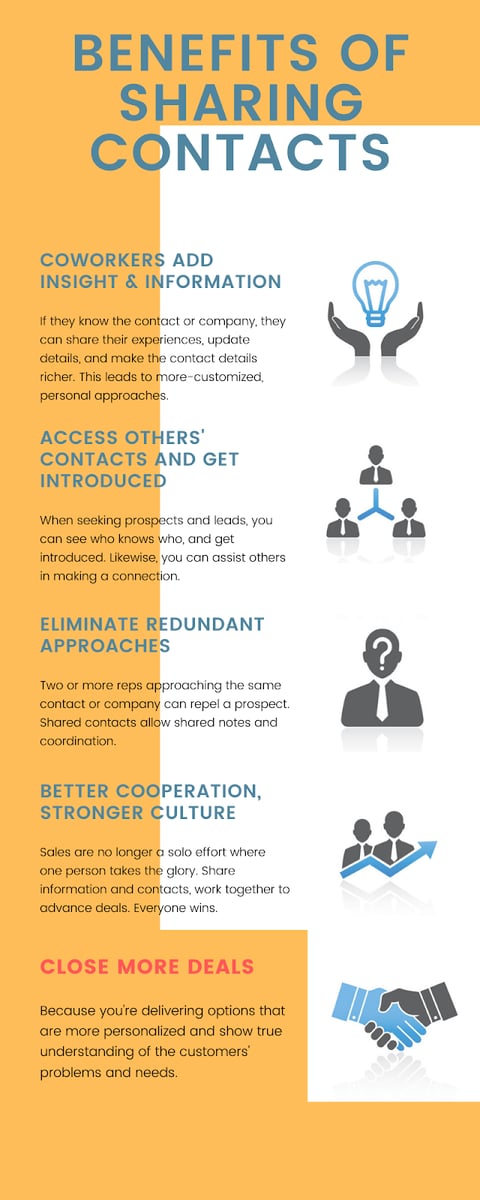January 30, 2020
 by Adam Goulston / January 30, 2020
by Adam Goulston / January 30, 2020

Don’t believe the hype about inbound marketing replacing cold prospecting.
Good inbound marketing brings leads, but it takes patience, targeting is harder, and customer acquisition cost (CAC) can run high. Cold prospecting is proactive, goes straight to the target, and initiates the dialogue needed for sales.
But robocalls, phishing, scammers, and more are making uninvited contacts less welcomed than ever. It’s no wonder more than 40% of salespeople view prospecting as the hardest part of the sales process, and think buyers view them as pushy and annoying.
Despite the stigma, salespeople still use the phone, and email, a lot. Those who do cold prospecting well generate 2.7× more sales meetings than the rest.
We need our sales hunters and we can help reduce their stress in ways that benefit the whole company. With cloud technology, centralized contacts, and a culture of internal referrals, warming up prospects is easier and more effective than ever. Here’s the why and how to do it.
Cold prospecting is finding and contacting potential customers with whom there’s been no previous contact. The notorious part of this is the cold calling. In fact, it doesn’t have to be cold. Sales intelligence and social selling can warm up prospects before the outreach stage, though nothing beats a warm introduction.
That’s fine if you know someone to introduce you. But what if you don’t? Easy.
If anyone is six degrees of separation from anyone else, then in the workplace we’re often down to one or two degrees. An average LinkedIn user has 400 connections, according to one study. That means anyone in the company is just one person away from anyone else’s 400 connections, and that’s just on LinkedIn.
If sales reps can find these links before the outreach, they can seek an “internal referral” and get that warm introduction.
Back-office staff also have contact with prospects, just not in a sales capacity. These are all valuable human relations that establish social capital and can open other doors. The challenge is to find out who in the company has a connection with the prospect.
By visualizing networks through centralized contacts, the unlikeliest of connections can easily lead to internal referrals bridging to pre-qualified prospects.

While cooperative work culture has gained plenty of attention, little is written on centralized contacts and on contact sharing. The practice is common in teamwork-driven culture, such as in Japanese companies, but it’s still something of a hidden secret elsewhere. The following steps will get you there.
To share contacts and internal referrals, there must be a centralized repository of customer data. Making it cloud-based adds a level of security and makes it accessible anywhere. But where are your company’s contacts? Usually they’re in desks, LinkedIn accounts, phones, even Rolodexes. They’re all private places, so you can’t go there.
Where you can go is the CRM or the contact management system (CMS). Both, ideally, are company-wide (central) and cloud-based (secure and distance-agnostic).
CRMs are nearly ubiquitous: 91% of businesses with 11+ employees use a CRM. So you probably have one. The Salesforce dashboard and HubSpot are prospecting sources in waiting. The CRM introduction process is also a chance to empower people and show commitment to transparency.
Enlist the end users to help choose a CRM that they actually want. If you like your current CRM, keep it, expand its use, and audit it at least annually. CRMs do, however, lack non-lead connections, and that's where we can help them.
TIP: Find the right CRM solution for your needs today.
Leads and customers comprise most contacts in a CRM. Those all represent future prospects if the deals don’t work out, but what’s lacking are:
Each human encounter has the potential for collaboration and new ventures. If not for the owner, then for someone else. These contacts are more likely to be held on a personal PC or device, in physical form, or in a CMS if you’re lucky. A good CMS is invaluable here, and distinct from the CRM.
A comprehensive CMS that is designed for all contacts lets you digitize (by scanning) accurate contacts, visualize connections, eliminate duplicate accounts and data, and it can enrich and update your CRM data when integrated. Or used on its own if it has CRM functions for tracking leads and accounts. This solution gives the company centralized, cloud-based, up-to-date contact data of all types of business contact.
A CRM is only as good as its data, and the data’s only as good as how it’s used. You’ll need a system for supplying the CRM, or CMS, with new contacts, day in and day out. And it has to be automated and easy because salespeople spend 17% of their time on tedious data entry when they could be selling.
Leads and contacts come from many places and in many forms, including social media, direct mail, trade shows, and even casual encounters. They can be in digital format or on paper, and they can contain as little as an email address.
Business cards may be the most useful format for all of these, because they’re a single card of very accurate customer data. After all, who has a business card with the wrong email or their name misspelled? They can also be scanned straight to the CRM or CMS. Tell your CEO who’s still having the admin type them into a spreadsheet.
Identify the types of contacts, especially business cards, see how you’re going to digitize them (scanning, manual entry, etc.), and get them in the CRM or CMS. This will be the initial roundup, if necessary. Then make it a regular process. Mandate CRM/CMS use if you must, but be sure to make the benefits abundantly clear.
To keep expanding the contact database, creating potential links, and to keep data fresh, contacts must be entered on a daily basis.
The main methods of entering contacts into the CRM are:

Companies that build a culture of internal prospecting see improved cooperation, sales, and efficiency. Sales prospecting starts in the company, not with risky contact lists and buying of leads. Browse your company’s leads, contacts, and other contracts. Find a target, or someone a degree away, and ask the contact’s owner for an introduction.
With a culture of internal referrals, staff help each other. Coworkers from different departments collaborate when otherwise they would’ve been off in their own sections and branches. These positive relations are scientifically proven to boost morale and prevent stress.
Give and receive. That’s good work culture, which is something salespeople rate as more important than money. And when 54% of salespeople find their job stressful, this can go a long way to keeping them onboard. You may need a mandate at the start, but it’s best if staff see the logic and huge benefits, and if they buy in.
Two common psychological obstacles to the sharing approach are the fear of being “found out” for the work you’re doing and the reluctance to share contacts for fear of someone stealing them.
Accepting and overcoming these fears is the key to regular contact sharing. When they’re ignored is when people go back to their own Gmail contact list, iPhone address book, Rolodex, and so on. The benefits are many, but they’re not commonly understood.
Salesforce gets it: “Salespeople need to lay aside their egos and find ways to work smartly together, harnessing their strengths in a complementary way for the good of the whole team.”
That’s especially in the case of complex deals, deals in danger of being lost, and deals where the rep lacks specific knowledge. But it should be extended to all deals. Sharing contacts and working cooperatively is a healthy way to work, and technology makes it possible.

When marketing and sales are collaborating with intent, and all departments are on board on the CRM or CMS, you’ll have a rich supply of leads at minimal CAC.
The new perspective here is you want to get all employees onboard and using the system, not just sales and marketing. IT, HR, admin, everyone who collects contacts needs a CRM user account, training, and ongoing support.
Sales ops can start this and serve as facilitators. It also helps to have advocates on each team. Granted, some departments may find it odd to take part in this effort, but this is where CMS systems have an advantage for centralizing contacts.
There are also non-sales situations where a centralized contact database comes in very handy. These include: seeking trustworthy suppliers, recruiting, and inviting attendees to events. Any situation in which you need to know someone but lack a connection. Industry, academia, and government have all been found to benefit from centralized contact data and contact sharing.
You’re asking quite a bit by having people share their contacts, and the benefits may not resonate with people set in their ways. Sweeten the deal by adding on tools that are easy to learn and that will further encourage interaction while reinforcing and rewarding great efforts to adapt.
These include:
Even better, survey your staff and see what they’ve found and what they’d love to have. Now you’re culturally and digitally transforming.
A salesperson’s network is something they worked hard to build, and it’s their moneymaker. They’re very protective of it, naturally, so implementing centralized, shared contacts is bound to get pushback.
To be clear, reps don’t need to share every contact they’ve ever acquired (as wonderful as that would be). Their LinkedIn is theirs. Their iPhone address book is theirs. But they do need to share contacts they acquire in the course of their work in the company. The same applies for people in all departments. Prospecting and closing deals becomes a companywide project.
When 86% of workers cite a lack of collaboration for workplace failures, and when companies like Pixar deliberately design their offices so people have random encounters that spark new ideas, there’s ample proof that collaboration is desirable.
Also, if a salesperson moves on to another company, they don’t take all their contacts with them. Those leads are a corporate asset. When they’re shared, another rep on your team can take over the account.
Use your tech, share and cooperate, and the cold in cold prospecting all but vanishes.
If you're looking for more ways to boost your prospecting success, check out what seasoned sales professionals say are must-dos for your prospecting efforts.
Adam Goulston is a US-born, Tokyo-based digital marketer and writer serving companies, NGOs, and academia in multiple countries. Adam is the Content Manager at Japanese SaaS firm Sansan.
No matter what business you’re in, you will grapple with the lead generation process at some...
 by Mary Siewierska
by Mary Siewierska
Is acquiring new customers important to your business?
 by Izabelle Hundrev
by Izabelle Hundrev
As if attracting and qualifying new prospects isn't hard enough, sales reps also need to put...
 by Anastasia Chechkova
by Anastasia Chechkova
No matter what business you’re in, you will grapple with the lead generation process at some...
 by Mary Siewierska
by Mary Siewierska
Is acquiring new customers important to your business?
 by Izabelle Hundrev
by Izabelle Hundrev


